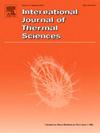Gas/liquid slug flow-based thermal management technique for enhanced proton exchange membrane fuel cell performance
IF 5
2区 工程技术
Q1 ENGINEERING, MECHANICAL
International Journal of Thermal Sciences
Pub Date : 2025-02-11
DOI:10.1016/j.ijthermalsci.2025.109756
引用次数: 0
Abstract
The present study numerically investigates the use of gas/liquid slug flows for the thermal management of a proton exchange membrane fuel cell (PEMFC). Given that a significant portion of the energy produced by PEMFCs is dissipated as heat, effective thermal management is crucial for enhancing their efficiency and operational stability. To address this, a three-dimensional, multi-phase, and non-isothermal model of a PEMFC is developed using OpenFOAM. The governing equations are discretized using the finite volume method, and the volume of fluid method (VOF) is adopted to capture the gas/liquid interface across the cooling channels. The effect of two-phase cooling is examined on the temperature distribution, water content distribution, proton conductivity, and the current density of the PEMFC for different two-phase Reynolds numbers. Moreover, the thermohydraulic performance of the slug flow is evaluated using a well-defined performance evaluation criterion (PEC). The results indicate that two-phase cooling outperforms single-phase cooling of PEMFC, achieving up to enhancement in the convective heat transfer coefficient, which leads to a reduction in the membrane temperature. Additionally, PECs up to 1.4 are reported for the slug flows. These enhancements indicate possible uses in automobile fuel cell systems, portable power sources, and backup power systems. This study may stimulate additional research via experimental endeavors and the investigation of novel cooling methodologies.
提高质子交换膜燃料电池性能的气/液段塞流热管理技术
本研究对气液段塞流在质子交换膜燃料电池(PEMFC)热管理中的应用进行了数值研究。由于pemfc产生的能量有很大一部分以热量的形式散失,因此有效的热管理对于提高其效率和运行稳定性至关重要。为了解决这个问题,使用OpenFOAM开发了一个三维、多相、非等温的PEMFC模型。采用有限体积法对控制方程进行离散化,采用流体体积法(VOF)捕捉冷却通道上的气液界面。研究了两相冷却对不同两相雷诺数下PEMFC的温度分布、含水量分布、质子电导率和电流密度的影响。此外,采用定义良好的性能评价准则(PEC)对段塞流的热水力性能进行了评价。结果表明,两相冷却优于单相冷却,对流换热系数提高了65%,膜温度降低了9.6%。此外,据报道,段塞流的PECs高达1.4。这些改进表明了汽车燃料电池系统、便携式电源和备用电源系统的可能用途。这项研究可能会通过实验努力和对新型冷却方法的研究来激发更多的研究。
本文章由计算机程序翻译,如有差异,请以英文原文为准。
求助全文
约1分钟内获得全文
求助全文
来源期刊

International Journal of Thermal Sciences
工程技术-工程:机械
CiteScore
8.10
自引率
11.10%
发文量
531
审稿时长
55 days
期刊介绍:
The International Journal of Thermal Sciences is a journal devoted to the publication of fundamental studies on the physics of transfer processes in general, with an emphasis on thermal aspects and also applied research on various processes, energy systems and the environment. Articles are published in English and French, and are subject to peer review.
The fundamental subjects considered within the scope of the journal are:
* Heat and relevant mass transfer at all scales (nano, micro and macro) and in all types of material (heterogeneous, composites, biological,...) and fluid flow
* Forced, natural or mixed convection in reactive or non-reactive media
* Single or multi–phase fluid flow with or without phase change
* Near–and far–field radiative heat transfer
* Combined modes of heat transfer in complex systems (for example, plasmas, biological, geological,...)
* Multiscale modelling
The applied research topics include:
* Heat exchangers, heat pipes, cooling processes
* Transport phenomena taking place in industrial processes (chemical, food and agricultural, metallurgical, space and aeronautical, automobile industries)
* Nano–and micro–technology for energy, space, biosystems and devices
* Heat transport analysis in advanced systems
* Impact of energy–related processes on environment, and emerging energy systems
The study of thermophysical properties of materials and fluids, thermal measurement techniques, inverse methods, and the developments of experimental methods are within the scope of the International Journal of Thermal Sciences which also covers the modelling, and numerical methods applied to thermal transfer.
 求助内容:
求助内容: 应助结果提醒方式:
应助结果提醒方式:


